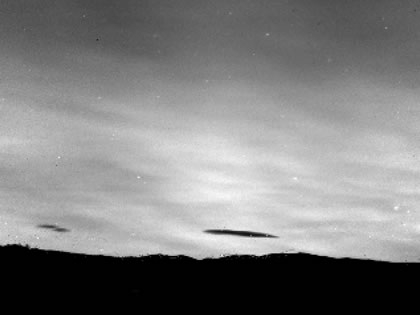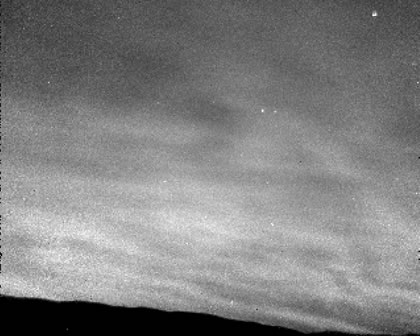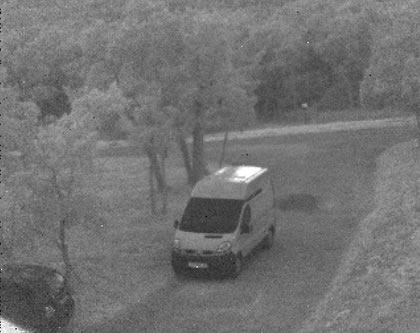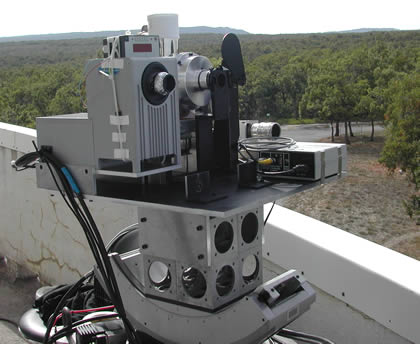Nightglow – The light of the night
On clear moonless nights, far from towns, the sky is full of star constellations. However, the light from these stars provides virtually no illumination on Earth. Thus, the scientists at Onera set about gaining a better understanding of nightglow", a weak natural illumination in the near infrared range of visible light, emanating from the sky.
"

copyright © Onera 2010 – All rights reserved
Two clouds in contrast against a background sky, illuminated by the near infrared emission induced by OH molecules in the upper atmosphere. This is the nightglow phenomenon.
This nightglow is due to OH molecule radiation in the upper atmosphere (at an altitude of around 84 km). Its emission spectrum stretches from 0.5 µm to 2.5 µm (reminder: the visible light spectrum ranges between 0.4 µm and 0.7 µm) and is at a maximum around 1.6 µm.
This radiation interests upper atmosphere specialists to the extent that, once identified, it indicates an atmospheric layer that can change with atmospheric conditions: gravity waves, temperature variations, etc. However, it is also of great interest for the DGA – Arms Procurement Agency, which sees it as a potential global lighting source for cloudless and moonless nights.

copyright © Onera 2010 – All rights reserved
Characteristic structure in OH emission bands in the near infrared range, due to undulating phenomena in the upper atmosphere (gravity waves)

copyright © Onera 2010 – All rights reserved
Scene measured in the 1.4 – 1.8 µm spectral band on a moonless night
Also, as part of a REI (Exploratory Research And Innovation) initiative, Onera, together with the Observatory of Besançon and the DGA, has implemented a field campaign, aimed at characterizing the spectral, spatial and temporal variabilities of this radiation and at assessing their use for ground scene observation. The measurements were taken in a near infrared spectral band around 1.6 µm, with a camera developed at Onera (Aïquido laboratory). This camera, cooled using liquid nitrogen, uses a new detector technology developed by the CEA/Leti and Sofradir: The infrared mosaic is constituted of avalanche photodiodes, built with a HgCdTe (Mercury-Cadmium-Tellurium) semiconductor.
As shown in the pictures on this page, nightglow has a good potential to provide "lighting" that is sufficient for night vision, using an appropriate camera, of course. Researchers at Onera now plan to: develop a camera that is sufficiently sensitive, light, manageable, uncooled and capable of exploiting the advantage of near infrared around 1.6 µm.
This first campaign devoted to the characterization of near-infrared nightglow will therefore have attained the first scientific objectives of this REI (a second campaign and modeling work are still planned). As far as operational issues are concerned, a number of steps remain to be taken before we have devices that are portable and easy to use in a field of operations. Work on this will begin at Onera in 2011.
Making use of its own exploratory research, Onera will be quite at ease in moving on to the development of a technology demonstrator, paving the way for industrial innovation.

copyright © Onera 2010 – All results reserved
Camera developed at the Onera Aïquido laboratory (at the center of the plate) installed for this campaign on the Haute-Provence Observatory site
Images: Onera / Department of Theoretical and Applied Optics
This work has been done by teams from the “Calibration, Instrument Building and Optical Measuring” unit and the “Optical Instrument Design” unit of the Department of Theoretical and Applied Optics at Onera, in collaboration with the Utinam Institute of the Observatory of Besançon and the DGA/Aeronautical Techniques. Interview for this article with Pierre Simoneau, optics research engineer at Onera, conducted by Sylvain Gaultier (web).